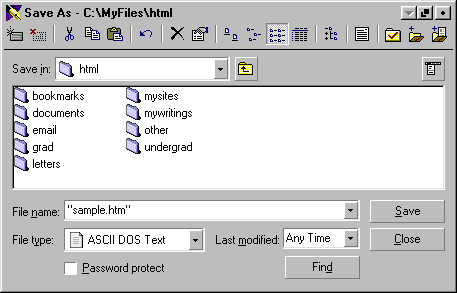Writing your page: editors
Webpages can be written with any text editor as well as with word processors. There are numerous "WYSIWYG" (What You See Is What You Get) editors for creating and editing webpages. Netscape Composer (part of the larger Netscape Communicator package) is one such editor. Providers of free webpages, such as GeoCities and Tripod often provide their own, web-based tools. This page discusses the tools you will be using to create your first webpages.
Text Editors
Text editors do exactly that: they edit text. They do not have many fancy WYSIWYG features, such as "bold", "italics" or "centering"; these are features left for type-setting and page-layout programs, or for word processors. Since webpages are simply text files with HTML tags included, text editors are both appropriate and all you'll need for creating and editing webpages.
The program "Notepad" (usually listed under Start --> Programs -- Accessories in Windows 95/98/NT) is a simple text editor. If you are using a shell account or working at a Linux/Unix terminal, you will most likely use either vi or emacs, or even pico. The first two are very full-featured text editors; the latter is quite user-friendly and easy to get used to. If you are using a Macintosh, you can use a program such as Simple Text; the commercial BBEdit package is a marvelous text editor.
Word Processors
Word processing programs such as MS Word and Corel Word Perfect can also be used to create and edit webpages. Word processors include many features (bold, italic, etc.) that will not be used when working on webpages.
Newer word processors allow you to save your documents as webpages (as HTML documents); this feature allows you to use your word processor as a type of WYSIWYG web-authoring tool. This feature, although useful, will not be covered here.
WYSIWYG Editors
There are numerous products on the market to make the creation of webpages easier; many fall under the category of WYSIWYG (What You See Is What You Get). Some are free, most are commercial. Their quality varies greatly with regard to the HTML code they produce. With such editors, the user does not deal with the editing of HTML, but instead with the direct layout and formatting of content.
Although this appears to be a fine solution -- relieving the user of needing to know HTML -- it has its pitfalls. In particular, the code produced by such products is often difficult to read. This is of importance when one needs to fine-tune or maintain HTML code down the road. In addition, when using such products, users design pages based on how they look on the particular computer being used. However, the author of a webpage often has little to no control over what sort of computer is used to view a site or page. What looks good at high resolution on one machine may look terrible on a machine with a lower resolution display. WYSIWYG tools are precisely that: tools. They are not crutches; hence I advocate the learning of HTML before one begins to rely of WYSIWYG editors.
Saving your Files
Assuming you are using a word processor or a text editor, you must pay care to how you save your files. On a Macintosh, no file extention (suffix) is given to files by default: you must remember to label your files with ".htm" or ".html". The same is the case when using most Linux/Unix editors. In Windows, the program being used usually gives the file you're saving a default extention; you will have to make sure to give it an ".htm" or ".html" ending.
Note: If you are using DOS or Windows 3.1 (or earlier), you will have to use the ".htm" ending, and keep your file names to no more than 8 characters in length due to the DOS 8.3 limitation.
Finally, if you are using a word processor, you must "override" the default file format when saving your files. By default, MS Word saves files as MS Word documents. Similarly, Corel Word Perfect saves document as Word Perfect documents. The following instructions show how to save a file as webpage in Word Perfect 8 in Windows; you can follow a similar method for MS Word and other word processors (in Windows, on the Macintosh, or in Linux/Unix), as well as for many text editors.
Instructions

Save As dialogue box in Word Perfect 8
- Choose "Save As" from the File menu (note: do not choose "Save")
- In the blank for "File type", choose "ASCII DOS Text" -- this is plain text
- In the blank for "File name" give your file a name. If you are using Windows 95/98/NT, place " " (quotation marks) around the name of the file. [This guarantees your file receives the ".htm" or ".html" extention, and not ".txt"]
- Click "Save"
Conclusion
A simple text editor is a powerful tool for creating webpages. Similarly, a standard word processor can be used to create and edit your webpages. WYSIWYG tools exist but are not necessary; furthermore, it is beneficial to first learn to create/edit pages with a normal editor before going on to WYSIWYG tools. Remember to be careful, though, when saving your HTML files.
This site © copyright 1999, Steve Krause, all rights reserved.